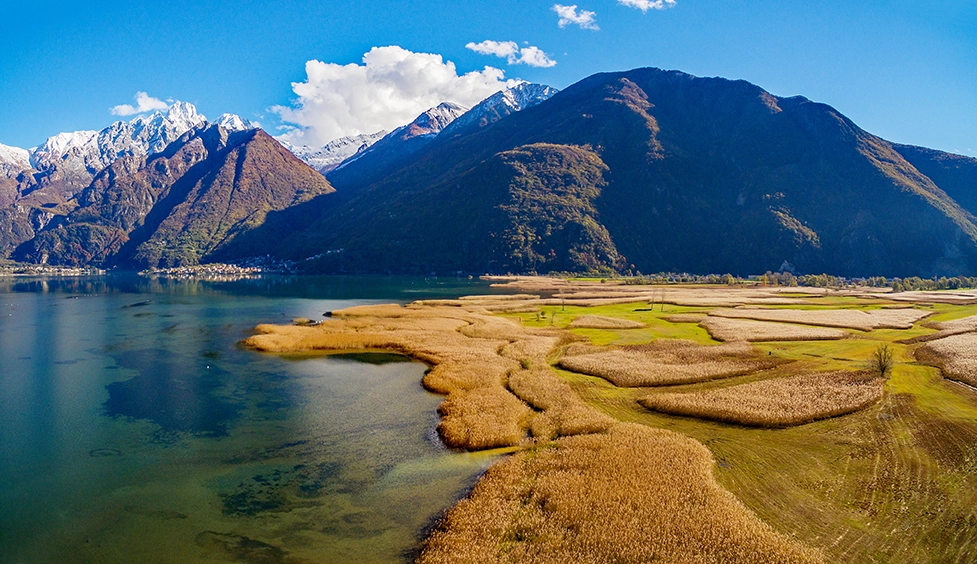Visit the pian di spagna
Visit the pian di spagna, one of the most interesting natural habitats on Lake Como, a protected oasis for various resident and migratory bird species..

The origins of Pian di Spagna
At the beginning of the 17th century, the Spaniard Count Fuentes was sent to rule Lombardy, and he devoted himself to the building of many military works. Very soon he comprehended the strategic importance of the Upper Larius zone; therefore he had a fortress built not far from Colico, at the mouth of the river Adda, in the area that was to be known as Pian di Spagna (Plain of Spain). The purpose of this grand work of military engineering was to protect the State of Milan either from the continuous raids of the Grisons, who had always longed to conquer the upper Larius lands, or to keep clear the roads of communication with Spain through the Alpine passes in case of war.
Count of Fuentes proved to be a good manager, maybe the best among the Spaniards that till then had been sent to Lombardy. He promoted the unification of both solid and liquid "weight and measure" in the whole Dukedom; a reform that eased and quickened commercial exchanges between industrial towns, which till then had utilized different unit of measure. About the Fort of Fuentes, the historian Della Torre Rezzonico writes as follow:
The fort was built on a hillock at the left side of the river Adda, as to close the ways to Lecco and Milan, although today, after the last stretch of the Adda has been deviated, its remains are by the banks of the river. The plan of the fort was at trapezium with star shaped ramparts, after the Lombard Military way of building of that time, which principal axis reached 370 meters. In 1782, the fort was military deserted and it was dismantled in 1796. Nowadays, a good number of its remains has been restored and opened to the public. Surrounded with vegetation there are the chapel, the troops’ quarters and some other services, while the rampart which characterized the stronghold completely disappeared.
Pian di Spagna: what to see
It is a wide marshy area, which surrounds the lake of Mezzola between the mouths of the rivers Mera and Adda. It is one of the most important naturalistic habitats of the Larius region and it is also a protected oasis for a number of both sedentary and migrant birds. The area owes its name to the Castle and stronghold of Fuentes the Spaniards built in the 17th century.
The lake is surrounded by a wide reed-thicket and its slimy plate hosts large colonies of invertebrates. Towards the mountains there are tree-lined sown fields and meadows with lacustrine plants.
In the past centuries, the presence of a wide marshy area was considered as a hindrance to development, but nowadays, since Pian di Spagna has been recognised a damp area of international interest, it has become a place for tourists who want to do Bird Watching.
Pian di Spagna: The church of San Fidelino
The church, dedicated to the Martyr Saint Fedele, is set on the west shore of lake Mezzola and because of its dimensions, it is known as Little San Fedele, which is also one of the most interesting monuments of Lombard Romanesque.
It is thought that right in this place was rescued the corpse of the martyr, who was immediately translated to Como in the church of Saint Euphemia then dedicate di Saint Fedele. The little church of San Fedelino was undoubtedly built within the last decades of the 900, and so it is one of the very first examples of Como Romanesque. The antiquity of the church is also witnessed by its uneven walls built with rocks, salvage building materials and pieces of different coloured marbles. The nave is 3,50 mt. long and it likely was all covered with frescoes now almost all vanished. Of the 11th century is the still visible fresco of the apse basin represents the Theophany.
The church is open from April to October: Sat, Sun and holidays 14.00-16.30; for openings outside these hours contact Mr Gianni (+39 333 7807686).

Read all curiosities